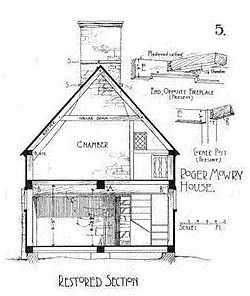Norman Isham

Norman Morrison Isham (1864-1943) was a prominent architectural historian, restorationist, author, and professor at Brown University and RISD.
Biography
Norman M. Isham was born in Hartford, Connecticut, but as a child his family moved to Providence, Rhode Island. Norman Isham attended Mowry and Goff's preparatory school and Brown University. He received a A.B. from Brown in 1886 and an A.M. in 1890. After graduation in 1886, Isham worked for architectural firm of Stone, Carpenter and Wilson and later Martin and Hall. He also served as an architecture instructor at Brown University.[2]
In 1899 Isham and Benjamin Wright created an architecture partnership which existed from 1912 to 1920 and 1923 to 1933. Isham also chaired the architectural department at the Rhode Island School of Design. He was a member of the American Institute of Architects and the Royal Institute of British Architects and published several architecture texts, including "Early Rhode Island Houses" in 1895. Isham was well known for his renovations of many prominent early Rhode Island and other New England houses, particularly, stone-enders.[2]
Isham was a member of the General Society of Colonial Wars.
After Isham's wife, Elizabeth Barbour Ormsbee, died in 1917, he moved from Providence to Wickford, Rhode Island and constructed a permanent home there having summered in Wickford for many years. Norman Isham is buried in Wickford and has no descendants.[2]
Historic buildings restored by Isham
- Clemence-Irons House, Johnston, Rhode Island, 1691
- Clement Weaver House, East Greenwich, Rhode Island, 1679
- Eleazer Arnold House, Lincoln, Rhode Island, 1693
- Gilbert Stuart birthplace, Saunderstown, Rhode Island, 1751
- John Balch House, Beverly, Massachusetts, 1679
- Newport Colony House, Newport, Rhode Island, 1739
- Newport Brick Market, Newport, Rhode Island, 1762
- Smith's Castle, Wickford, Rhode Island, 1678
- Stephen Hopkins House, Providence, Rhode Island, 1708
- Redwood Library, Newport, Rhode Island, 1747
- Trinity Church (Newport, Rhode Island), 1725
- Wanton-Lyman-Hazard House, Newport, Rhode Island, 1697
- Whitehall Museum House, Middletown, Rhode Island, 1729
References and external links
- Isham bio
- Examples of Isham's work
- Norman Isham Papers Collection at the RI Historical Society
- Norman Morrison Isham, Albert Frederic Brown (1895). Early Rhode Island Houses. Preston & Rounds.
Notes
- ↑ Norman Morrison Isham, Albert Frederic Brown (1895). Early Rhode Island Houses. Preston & Rounds.
- ↑ 2.0 2.1 2.2 Norman Morrison Isham at home.sprynet.com
|